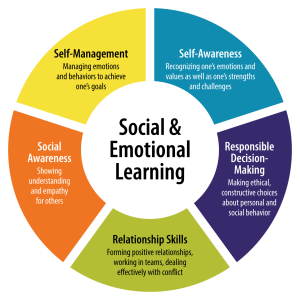About (SEL) social emotional learning
COMPONENTS OF SOCIAL-EMOTIONAL LEARNING (SEL):
There are many components to SEL but most literature states 5 key components. they are –
Figure: Five main components of social emotional learning (MLSD2022).
Self-Awareness
- Self-awareness is a conscious awareness of one’s own strengths, weaknesses, actions, and presence. Self-awareness necessitates a clear understanding of your mental and emotional states.
- Recognizing your emotions and how they influence your behavior; recognizing your strengths and weaknesses in order to gain confidence in your abilities.
Self Management
- Self-management consists of setting and achieving goals, as well as taking responsibility for your thoughts, emotions, and actions in various situations.
- Self-management consists of setting and achieving goals, as well as taking responsibility for your thoughts, emotions, and actions in various situations.
Social Awareness
- Social Awareness is the ability to put yourself in the shoes of another person who comes from a different background or culture than you.
- To act with empathy and integrity in your home, school, and community. Recognizing others, understanding the perspectives of others, and empathizing with them, including those from diverse backgrounds, cultures, and contexts, is what social awareness is all about.
Relationship Skills
- Relationship skills are the ability to form and maintain healthy relationships with people from various backgrounds. This competency focuses on knowing when to ask for or offer assistance, listening to others, and communicating with them.
- Students who participate in SEL learn how to handle conflicts in their relationships more effectively, making it easier for them to maintain their friendships (Banks, 2022). Because of their problem-solving abilities, they can work in groups and even enjoy teamwork in the classroom.

Comments
Post a Comment